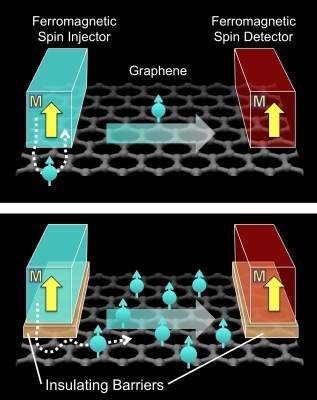Physicists at the University of California have taken a major step towards developing a “spin computer” by successfully tunneling “spin injection” into graphene.
“An electron can be polarized to have a directional orientation, called ‘spin.’ This spin comes in two forms: ‘up’ or ‘down’ – and allows for more data storage than is possible with current electronics,” explained UC associate professor Roland Kawakami.
“[Now], spin computers, when developed, would utilize the electron’s spin state to store and process vast amounts of information while using less energy, generating less heat and performing much faster than conventional computers in use today.”

According to Kawakami, graphene has amongst “the best” spin transport characteristics of any material at room temperature.
“This makes it a promising candidate for use in spin computers. But [still], electrical spin injection from a ferromagnetic electrode into graphene is inefficient.
“And an even greater concern is that the observed spin lifetimes are thousands of times shorter than expected theoretically. We would like longer spin lifetimes because the longer the lifetime, the more computational operations you can do.”
To address the above-mentioned shortcomings, Kawakami and his colleagues inserted a nanometer-thick insulating layer – known as a “tunnel barrier” – in between the ferromagnetic electrode and the graphene layer.

“We found a 30-fold increase in the efficiency of how spins were being injected by quantum tunneling across the insulator and into graphene. [This is because the] insulator was operating like a one-way valve, allowing electron flow in one direction – from the electrode to graphene – but not the other,” said Kawakami.
“[Clearly], the insulator helps to keep the injected spin inside the graphene, which is what leads to high spin injection efficiency. This counterintuitive result is the first demonstration of tunneling spin injection into graphene.”






